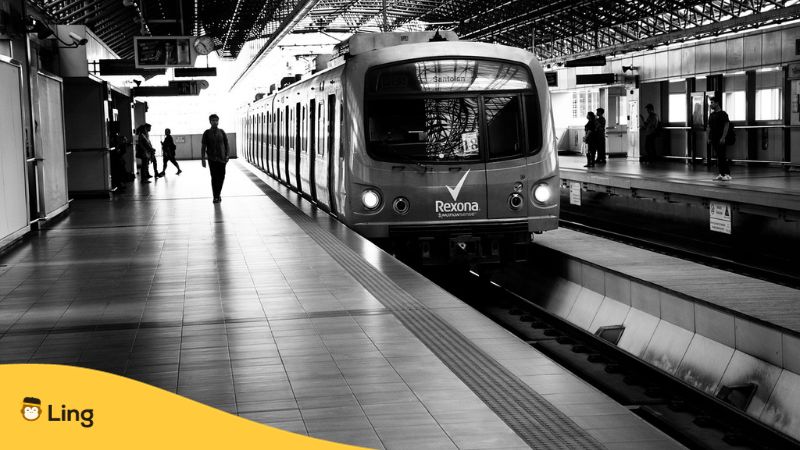Magandang araw (good day), folks! In the bustling metropolis of Metro Manila, knowing the Tagalog words for metro travel is your key to a smoother and more informed urban adventure. These words provide valuable insights into the local culture and ensure you navigate the city’s metro system with confidence. Join us as we explore Filipino words and phrases that will enrich your journey through this dynamic capital!
Metro Traveling In The Philippines
The country of the Philippines does not have a subway system yet. What the Filipinos are using is their metro, called Metro Rail Transit (MRT) and Light-Rail Transit (LRT). Metro travel in the bustling capital of Metro Manila, Philippines, offers an efficient alternative to the city’s notorious traffic. Yep, the reality is that the Philippines encounters heavy, heavy traffic. For example, a 30-minute trip on the road would become 1–2 hours! That is why using the Metro is the most convenient mode of transportation.
Still, even the MRT and LRT can get full, too, especially during rush hours. In that case, secure your stuff and prepare for a shoulder-to-shoulder journey! Nevertheless, it is still far more bearable than spending the next hours staring at the clock in a jeepney, minibus, or shuttle.

Basic Tagalog Words For Metro Travel
Metro travel isn’t just about getting from A to B; it’s a window into the daily lives and unique culture of this buzzing city. So, hop on board and let us learn some essential words for navigating the metro!
Train Station – Istasyon Ng Tren
Welcome to the “Istasyon ng tren” (Train station), the pulsating core of Metro Manila’s metro system! It’s more than just a stop; it’s a bustling hub of diversity and connections. Here, you’ll join a vibrant crowd of commuters, each with their own story. From this launchpad, you can explore iconic destinations like Ayala, Cubao, or North Avenue. And if hunger strikes, grab a local snack from nearby stalls. The istasyon is where you become part of the city’s lively rhythm. All aboard for the adventure!
Ticket – Tiket
A ticket, or “Tiket,” in Metro Manila is your passport to urban adventure. It grants you access to bustling stations and vibrant trains, connecting you with fellow travelers and stories. In the Philippines, you will find two types of tickets: single-journey and multi-journey tickets, which are called ‘Beep cards.’
A Beep card is a transportation card in the Philippines, offering convenient and smooth traveling not only in MRT or LRT but also in ‘istasyon ng bus’ (bus stations) for ‘Beep buses.’ These buses offer an air-conditioned interior—the best place for a very hot day in Manila. When used for the metro, the Beep card also has its perks! You won’t have to spend time in line to buy a single journey ticket—not to mention the small discount. The only duty you will have is to reload it. But how?
Ticket Machine – Makina Ng Tiket
A ‘ticket machine’ or ‘makina ng tiket’ is the most convenient way to reload your Beep card. You will immediately notice a machine in every MRT or LRT station. To use them, you just have to put your card on the machine, select your desired amount, and insert your cash. Very simple, right?
Ticket Booth – Ticket Booth
Unfortunately, there is no Tagalog/Filipino equivalent to ‘ticket booth.’ One of the main reasons is that the Filipino people use the English language as frequently as they use Tagalog, which means that you’ll still be understood even if you speak English whenever you run out of Tagalog words.
One downside of using a ticket booth is that during rush hours (usually 6-9 a.m. and 4-8 p.m.), you will always find a long line. Of course, this is not convenient at all. However, it is best if you are not going to use the metro multiple times.

Basic Tagalog Phrases For Metro Travel
Now that we are familiar with the essentials for Metro traveling in Manila, let us proceed to some useful basic phrases to get you going on your journey.
How Much Is The Fare? – Magkano Po Ang Pamasahe?
Knowing the price of the fare is one of the most important things to remember. To ask, simply say “Magkano po ang pamasahe?” (How much is the fare?) to the ticket booth or a fellow commuter. Although the fare is posted on the ticket booth’s screen, it is still better to ask just to be sure.
What Station Is This? – Anong Istasyon Po Ito?
Feeling a bit disoriented? Do not hesitate to ask the person next to you. Just say “Anong istasyon po ito?” (What station is this?). But don’t worry, because there will be a series of announcements on the train about what station you’re arriving at, both in Tagalog and English. Just make sure to keep an attentive ear.
Thank You – Salamat Po
“Salamat po” (Thank you)—these two magical words are your secret weapon in the Philippines. These words add a layer of respect and kindness to your conversations. It also means that you appreciate their courtesy whenever someone answers the previously mentioned phrases. After saying this, oftentimes you’ll be answered with “walang anuman!” (you’re welcome!).
Learn Tagalog With Ling
That’s it, eager minds! Those are the basic Filipino phrases to guide your travel to the city of Manila. But why not learn more about the Filipino language? From learning a few words with our blogs, you can rise to learning the Tagalog language itself! Start with common Tagalog phrases and get to the point where you can speak it flawlessly! And you can do it in a fun way with Ling!
The Ling app isn’t just your ordinary language-learning app; it’s your ticket to mastering Tagalog while having a blast! With gamified lessons, bite-sized chunks of knowledge, and an array of quizzes and games, learning Tagalog becomes an exciting adventure.
Whether you’re navigating the intriguing world of Filipino culture or simply impressing locals with your newfound language skills, the Ling app’s immersive approach makes it the ultimate choice. Say “magandang gabi” (good night) to boring lessons and “magandang umaga!” (good morning!) to an engaging, fun-filled Tagalog learning journey!
Download it now from the Apple App Store or Google Play Store!



































































